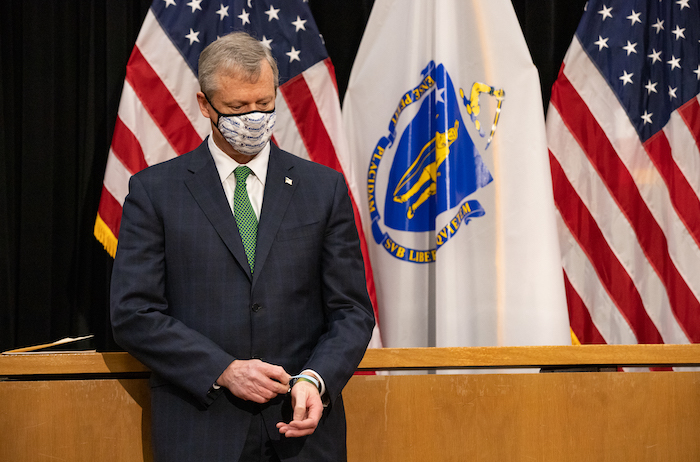latest
Projection: COVID Surge Likely To Peak Later This Month

By Chris Lisinski
As Massachusetts grapples with record COVID-19 case counts amid the omicron-fueled winter surge, two widely cited analyses offer different outlooks on the state’s public health footing.
The latest Massachusetts-specific projections from the University of Washington’s Institute for Health Metrics and Evaluation forecasts that daily case counts will continue to rise over the next week and a half, peaking around 53,000 per day — more than three times as high as the seven-day average case count reported Wednesday — by Jan. 22.
At the same time, the most recent Boston region wastewater data from the Massachusetts Water Resources Authority shows a sizable decrease in the rate at which COVID-19 has been detected in sewage.
While the pilot program’s data through Monday observed COVID at rates still well above any previous peak, the average rate of COVID-19 presence in wastewater appears to have turned a corner and started dropping last week.
Health experts and elected officials are still trying to get a clearer sense of how the arc of the latest wave will play out.
On Wednesday, the Department of Public Health reported 22,184 newly confirmed COVID-19 cases, roughly in line with recent daily case counts during the winter wave. The statewide seven-day average positive test rate stands at 21.61 percent.
The state’s high rate of vaccination — more than 5.1 million Bay Staters are fully vaccinated against COVID-19 — has helped limit the frequency of severe illness and death, but the health care system is grappling with enormous strain amid a combination of growing patient needs and labor shortages.
DPH reported 3,087 patients with COVID-19 in Massachusetts hospitals, the first time the count has surpassed 3,000 since May 12, 2020, just about two months into the public health state of emergency.
IHME’s model, last run on Friday using data through Jan. 3, projected that the strain on Bay State hospitals will keep growing over the course of January. The University of Washington-based institute estimated that the amount of hospital beds needed to treat COVID-19 would likely peak around 5,882 on Jan. 29, at which point Massachusetts would need roughly 1,600 intensive care unit beds for pandemic response.
Those figures are based on a range of possible outcomes, and the researchers said the ICU need could fall somewhere between about 755 and 2,800 beds.
Still, even if the ultimate figure lands in the middle of those two endpoints, it would represent enormous strain. The state’s most recent data said 171 ICU beds out of 1,278 total remain available, as do 550 out of 8,781 medical/surgical beds.
IHME also projected the typical daily increase in COVID-19 deaths will likely rise to 70 by Jan. 30 and that the Bay State could hit between 23,000 and 24,000 cumulative deaths by May 1.
DPH on Wednesday reported 75 newly confirmed COVID-19 deaths, and the seven-day average of new deaths per day now stands at 43.3.
An important distinction in hospitalization data should become public next week. For the duration of the pandemic, health care facilities have been reporting a single tally of patients with COVID-19 to the state.
Facilities this week began submitting data differentiating between patients who wind up in the hospital for serious cases of COVID-19 and those who test positive for the virus while seeking treatment for another issue.
A Baker administration official who agreed to communicate only on background said hospitals will divide patient counts into primary and incidental cases based on administration of dexamethasone, an anti-inflammatory steroid that medical professionals use to treat at least 90 percent of hospitalized COVID-19 patients.
The official said data including that distinction will become available the week of Jan. 17 and added to the online COVID-19 data portal shortly afterward.
-

 Community6 years ago
Community6 years agoNational Shrine of La Salette Festival of Lights 2017 set to begin
-

 Community6 years ago
Community6 years agoMassachusetts State Police looking for good home for retired dogs
-

 Crime6 years ago
Crime6 years agoFall River ranked most dangerous city in Massachusetts according to report
-

 latest6 years ago
latest6 years agoDurfee student allegedly overdoses on marijuana
-

 Community6 years ago
Community6 years agoVideo of Fall River Police goes viral
-

 Causes6 years ago
Causes6 years agoMissing Fall River woman found deceased
-

 Crime6 years ago
Crime6 years agoFall River Police add names to most wanted list
-

 Causes6 years ago
Causes6 years agoFall River teenager reported missing has been found




